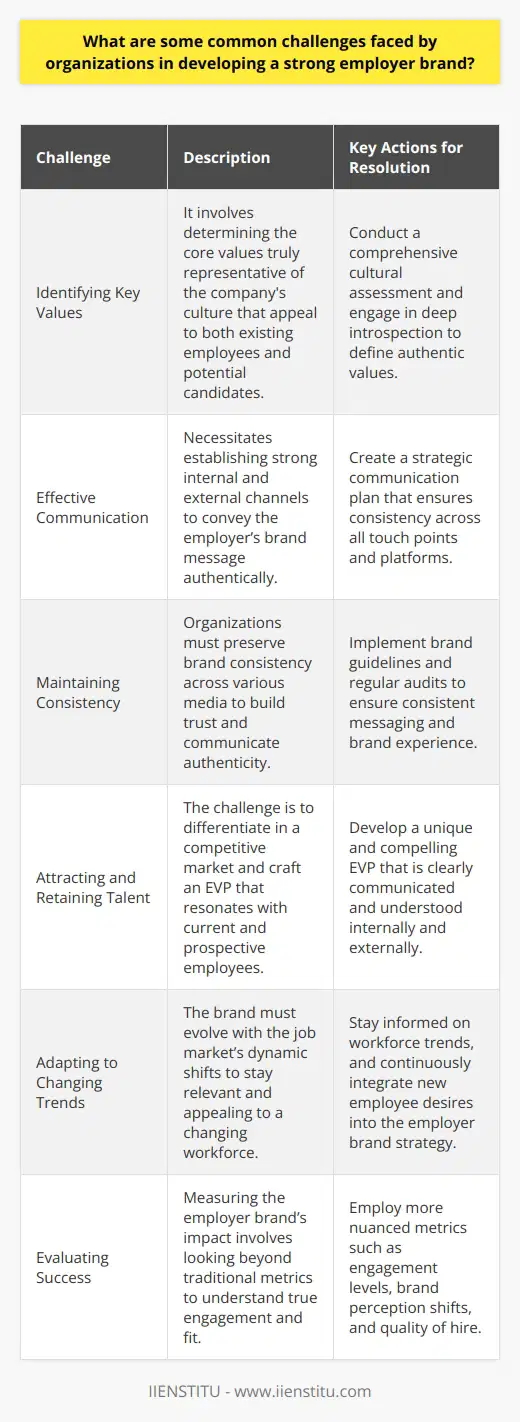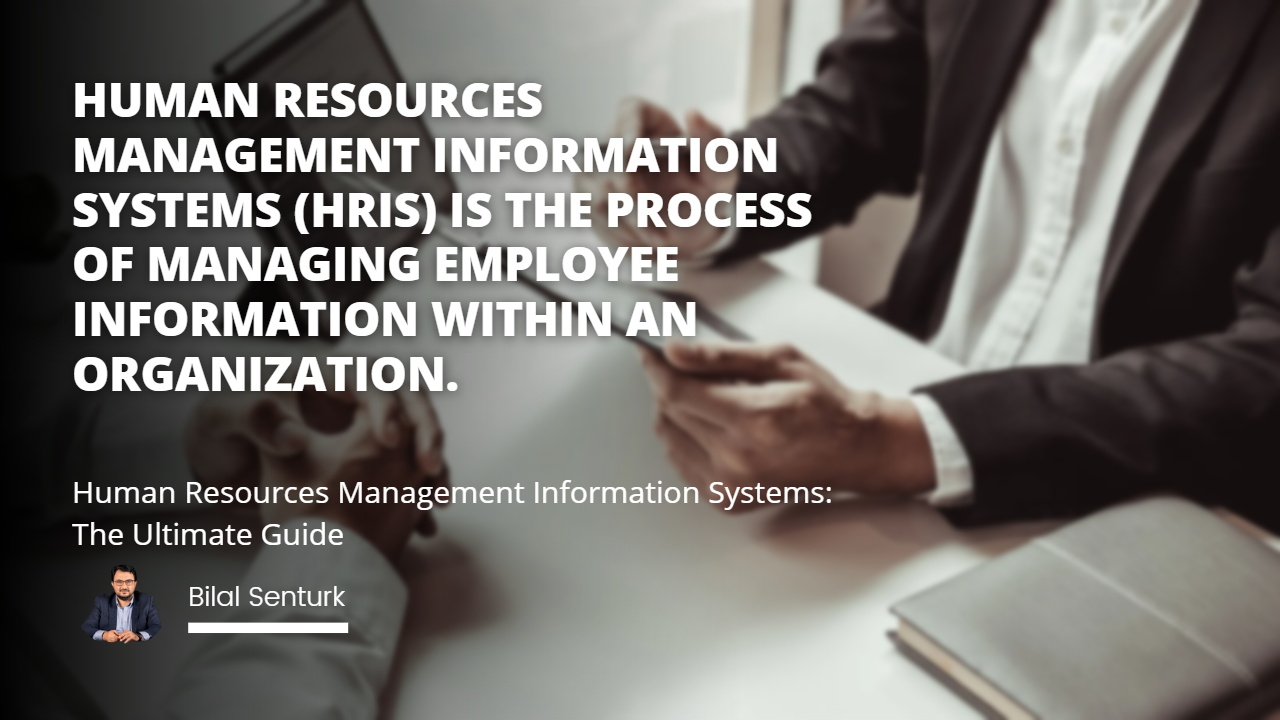
You know, back when I first dipped my toes into the world of business, I stumbled upon a concept that seemed both intriguing and essential: employer branding. At first, it sounded like just another buzzword tossed around in corporate meetings. But as I delved deeper, I realized its profound impact on how organizations attract and retain talent. It's not just about flashy logos or catchy slogans; it's about creating a genuine identity that resonates with people.
Understanding Employer Branding
What Exactly Is Employer Branding?
Employer branding is the process of crafting a unique identity for an organization, one that appeals to current and potential employees. It's a blend of marketing and human resource HR strategies aimed at showcasing what makes a company a great place to work. Think of it as the company's reputation as an employer, not just as a provider of goods or services.
Introduction
Definition of Employer Branding
The link between Strategy & Employer Branding
Employer Branding as a Relationship
Benefits of Employer Branding
I remember chatting with a friend who was contemplating a job offer from two companies. One had a robust employer brand with stories of employee growth, a vibrant culture, and strong values. The other was more mysterious, with little information available. Unsurprisingly, she gravitated towards the former. Employer branding made all the difference.
The Link Between Strategy and Employer Branding
It's fascinating how strategic human resource management ties into employer branding. Organizations don't just stumble upon a great employer brand by accident; it's a deliberate effort aligned with their overarching strategy. According to Martin and Hetrick in their book Corporate Reputations, Branding and People Management, a strong employer brand reinforces a company's strategic goals by attracting talent that shares its vision.
Employer Branding as a Relationship
At its core, employer branding is about relationships. It's the mutual trust and respect between an employer and its employees. When I worked at a startup, the founders made it a point to build genuine relationships with every team member. This approach cultivated loyalty and made us all feel like we were part of something bigger. It's not just business; it's personal.
The Benefits of Employer Branding
Attracting Top Talent
One of the most apparent benefits is the ability to attract top-notch candidates. A compelling employer brand acts like a magnet. Candidates today do their homework—they read reviews, check out social media, and get a feel for the company culture before applying.
Consider the tech giant Google. Its employer brand is so strong that it receives over a million applications annually! People are drawn to its innovative culture, employee perks, and the promise of working on cutting-edge projects.
Retaining Employees
But it's not just about getting people in the door; it's about keeping them. A strong employer brand fosters employee engagement and satisfaction. When employees feel valued and aligned with the company's mission, they're less likely to jump ship. It's like planting roots—they grow deeper over time.
Differentiating from Competitors
In a crowded marketplace, standing out is crucial. Employer branding helps differentiate a company from its competitors. It's the unique blend of culture, values, and work environment that sets one organization apart from another.
Employer Branding is the bridge between HRM, Strategy, and Leadership and is essential for successful business operations.
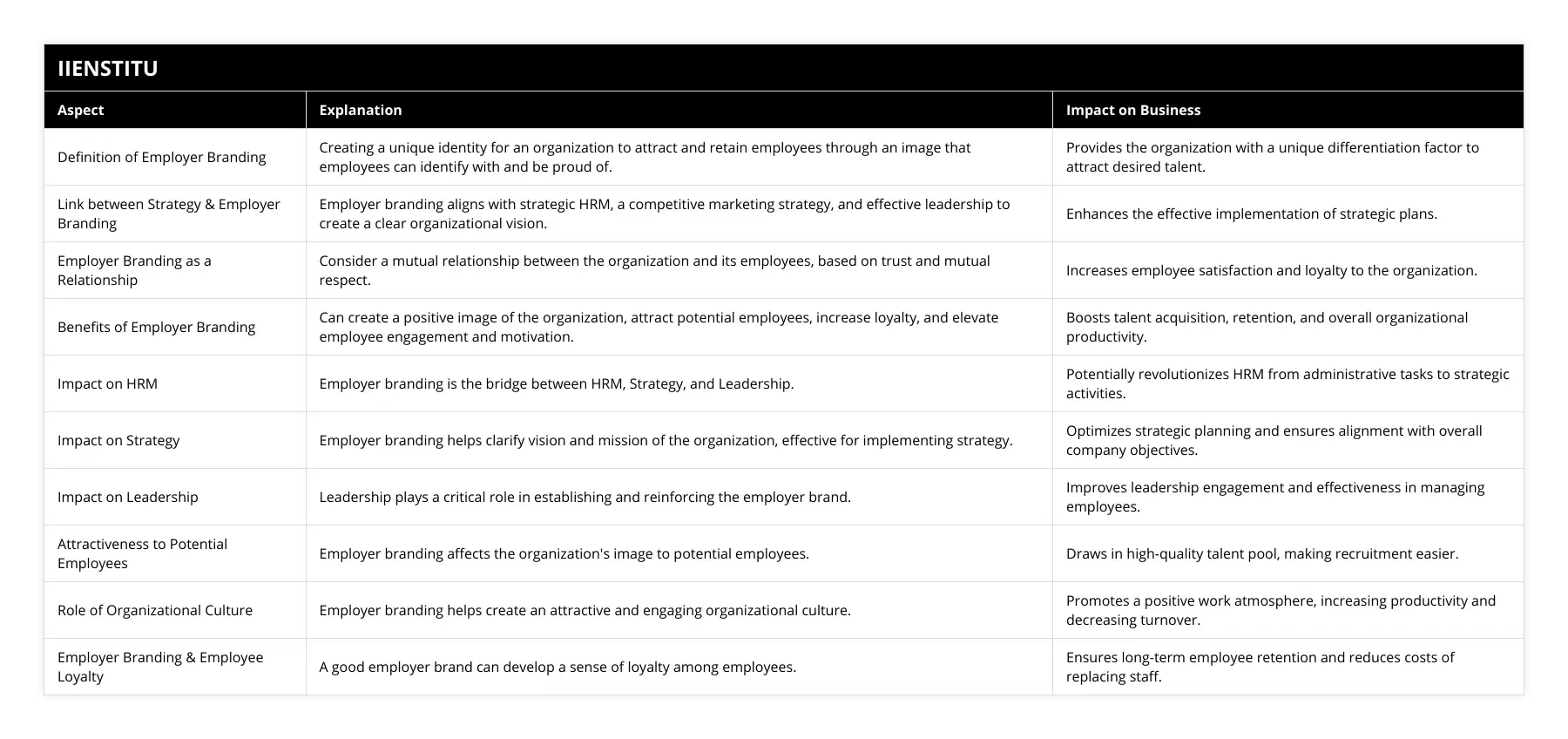
Enhancing Company Reputation
A positive employer brand doesn't just attract employees; it can enhance the company's overall reputation. Customers often prefer to buy from companies that treat their employees well. Happy employees often lead to happy customers.
Strategies for Building a Strong Employer Brand
Aligning with Company Values
Your employer brand should be a reflection of your company's core values. It's essential to walk the talk. If innovation is a core value, encourage creativity and new ideas. If customer service is paramount, ensure employees have the training and resources they need to excel.
Engaging Employees as Brand Ambassadors
Employees can be your best advocates. Encourage them to share their positive experiences. At my previous job, we were encouraged to share our projects on social media. It not only showcased our talents but also gave outsiders a peek into the exciting work happening behind the scenes.
Leveraging Social Media and Online Platforms
In today's digital age, online presence is everything. Utilize platforms like LinkedIn, Glassdoor, and even Instagram to showcase your company culture. Share stories, celebrate successes, and be transparent about challenges. Authenticity resonates.
Offering Professional Development Opportunities
Investing in employees' growth shows that the company values them. Offer training programs, mentorship, and clear career paths. When employees see a future with the company, they're more likely to stay engaged and committed.
Challenges in Employer Branding
Maintaining Consistency
One of the trickiest parts is keeping the employer brand consistent across all touchpoints. From recruitment ads to the onboarding process and daily work life, the experience should reflect the brand promises.
Adapting to Change
Organizations evolve, and so should their employer brand. It's essential to stay relevant, especially with changes in the market or shifts in organizational strategy. Flexibility isn't just a nice-to-have; it's a necessity.
Measuring Employer Branding Efforts
Quantifying the impact of employer branding can be challenging. However, using metrics like employee retention rates, application rates, and employee engagement scores can provide insights.
The Role of Leadership in Employer Branding
Leadership plays a pivotal role. Leaders set the tone for the company culture and embody the employer brand. They need to be visible, approachable, and authentic. In strategic HR management, leaders collaborate with HR to ensure that the employer brand aligns with the company's strategic objectives.
Personal Reflections
Looking back, I've seen firsthand how a strong employer brand can transform an organization. It's not just about flashiness or perks like free lunches and game rooms. It's about creating a place where people feel valued, challenged, and part of a community. When employees wake up excited to go to work, that's when you know the employer branding efforts are paying off.
Conclusion
Employer branding isn't just a trendy concept; it's a strategic necessity in today's competitive business landscape. By blending human resources information, marketing, and genuine leadership, companies can create an environment where both the organization and its employees thrive.
Remember, it's all about building relationships based on trust and mutual respect. When done right, employer branding not only attracts and retains talent but also propels the company towards long-term success.
References
1- Martin, G., & Hetrick, S. (2006). Corporate Reputations, Branding and People Management. Oxford: Butterworth-Heinemann.
2- Backhaus, K., & Tikoo, S. (2004). "Conceptualizing and Researching Employer Branding". Career Development International, 9(5), 501-517.
3- Barrow, S., & Mosley, R. (2005). The Employer Brand: Bringing the Best of Brand Management to People at Work. Chichester: John Wiley & Sons.
4- Edwards, M. R. (2010). "An Integrative Review of Employer Branding and OB Theory". Personnel Review, 39(1), 5-23.
5- Taylor, S. (2014). Resourcing and Talent Management. London: CIPD Publishing.
Key Takeaways:
Employer branding is essential for attracting and retaining top talent.
It's a blend of marketing and human resource management strategies.
Building a strong employer brand requires alignment with company values, employee engagement, and authentic leadership.
Challenges include maintaining consistency and adapting to organizational changes.
Leadership plays a crucial role in embodying and promoting the employer brand.
If you're considering enhancing your company's employer brand, remember it's not an overnight process. It takes time, effort, and a genuine commitment to creating a positive work environment. But trust me, the rewards are well worth it.
Frequently Asked Questions
What is the definition of employer branding?
Employer branding is a term used to describe developing and maintaining a positive reputation as an employer to attract and retain the best talent. The concept has become increasingly important as organizations seek to differentiate themselves in a competitive job market.
At its core, employer branding is about communication. It is about effectively conveying an organization's value proposition as an employer to potential candidates. The goal is to create an attractive and distinctive employer brand that communicates the organization's mission, values, and culture and to position it as an employer of choice in the minds of job seekers.
An effective employer brand should encompass the following components:
1. Reputation: The employer brand should communicate the organization's reputation as an employer, including its track record for employee satisfaction, quality of work, and development.
2. Values: The employer brand should communicate the organization's core values and how they are embodied in its business.
3. Culture: The employer brand should communicate the organization's culture, including how it treats its employees and encourages employees to work together.
4. Benefits: The employer brand should communicate the benefits of working for the organization, including its competitive pay and benefits, flexible working arrangements, and other perks.
5. Recruitment: The employer brand should communicate the recruitment process and the potential steps candidates should take to apply for a job with the organization.
By creating an attractive and distinctive employer brand, organizations can effectively differentiate themselves in the job market, attract the best talent, and develop a culture of employee engagement and loyalty.
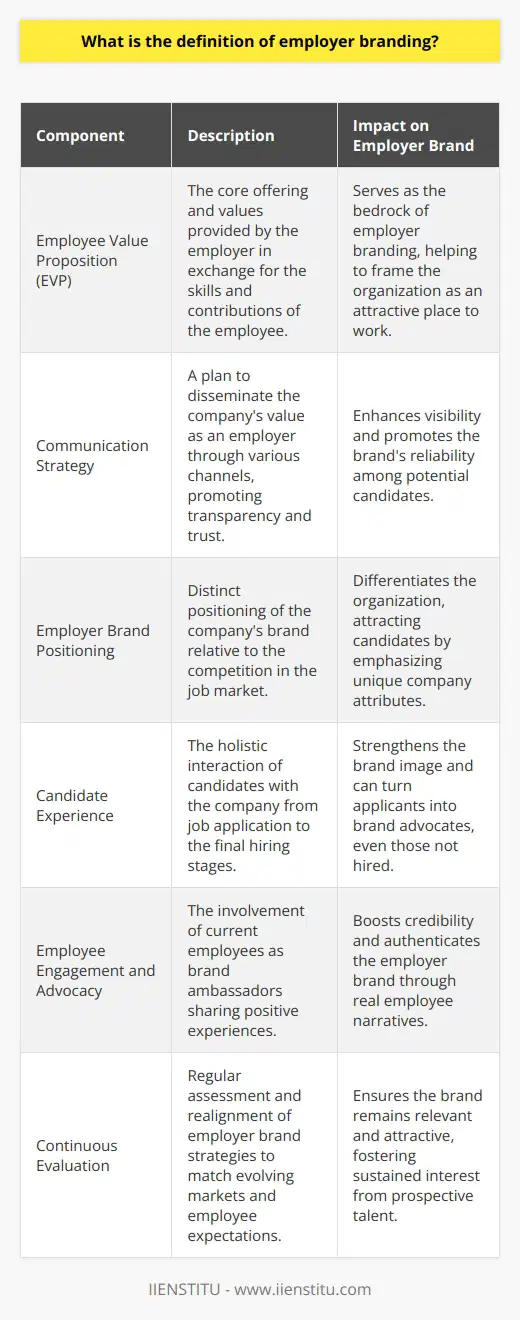
Employer branding is the process of creating a positive image of an organization as an employer in order to attract and retain the best talent. It involves creating a unique identity for the organization that reflects its values, culture, and mission.
Employer branding is critical to a successful business strategy in today's competitive job market. By creating a unique identity that reflects the organization's values, culture, and mission, employers can effectively attract and retain top talent. Employer branding is more than just a marketing tactic; it is a comprehensive process that requires a commitment to understanding the needs of potential and current employees, as well as developing a comprehensive strategy for recruiting, hiring, and retaining them.
The first step in effective employer branding is to develop a clear understanding of the organization's goals and values. This includes an analysis of the organization's competitive advantage, current and future workforce needs, and approach to workplace culture. This will help to develop a unique brand identity that reflects the organization's values and mission and creates a positive perception of the organization as an employer.
Once the employer's brand identity has been established, the next step is to create a comprehensive strategy for recruiting, hiring, and retaining the best talent. This includes utilizing traditional and digital recruitment tactics, such as job fairs, recruitment websites, and social media. It is also essential to ensure that the recruiting process is fair and transparent, that job postings accurately reflect the organization's values and culture, and that candidates are treated with respect throughout the hiring process.
In addition to recruiting, employers must also invest in creating an attractive workplace culture. This includes providing meaningful benefits, such as flex time and telecommuting options, as well as professional development and growth opportunities. Employers can attract and retain the best talent by creating an environment that respects employees and provides them with the tools they need to be successful.
Finally, employer branding is an ongoing process that requires consistent effort and thought. Employers must continuously evaluate their brand identity, workplace culture, and recruitment strategy to ensure that they are meeting the needs of their current and potential employees. By consistently investing in employer branding, organizations can create a positive image of themselves as an employer and effectively attract and retain top talent.
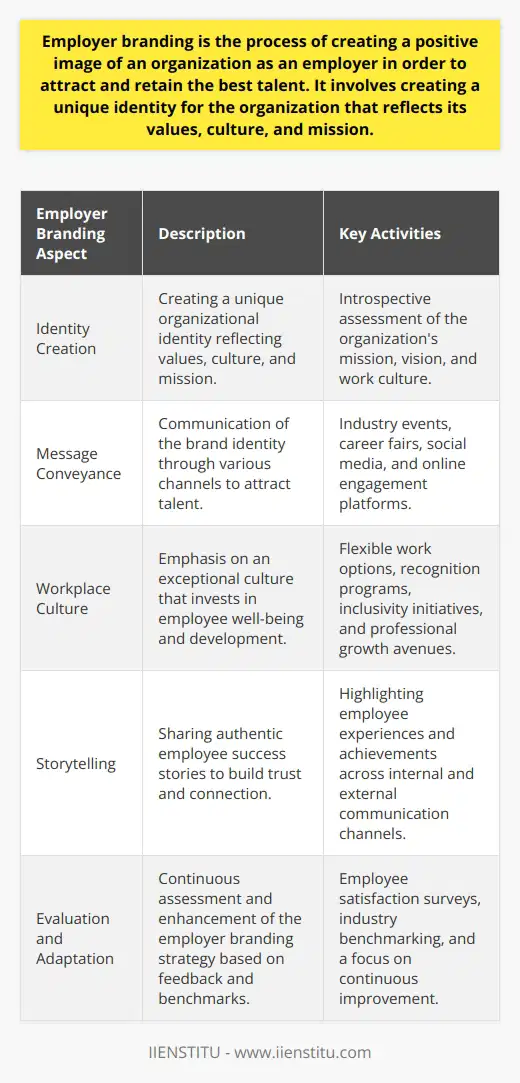
How does employer branding link to strategy?
Employer branding is increasingly seen as a strategic tool rather than a tactical one within the corporate context. Employer branding creates a positive image of a company in the minds of potential employees and current and former employees. Employer branding effectively differentiates a company from its competitors in the job market and demonstrates its commitment to its employees.
The strategic importance of employer branding stems from its role in the recruitment and retention of top talent. By creating a positive image of the company in the minds of potential employees, employer branding can help to attract more qualified candidates and to retain them for more extended periods. This can reduce recruitment and turnover costs and increase employee engagement.
Moreover, employer branding can also play a role in developing the company's overall strategy. By communicating the company's values, mission, and vision to potential employees, employer branding can help to ensure that the company's long-term objectives are understood and embraced by the workforce. This can help to ensure that the company's strategy is implemented effectively and to align the crew's efforts to the company's goals.
Finally, employer branding can also help to build and maintain relationships with key stakeholders, including customers, suppliers, investors, and the wider community. By demonstrating the company's commitment to its employees, employer branding can help to create a positive impression of the company and to establish trust and credibility in the broader community.
In conclusion, employer branding can be essential in developing and implementing a company's strategy. By creating a positive image in the minds of potential employees, employer branding can help to attract and retain top talent and to ensure that the company's strategy is implemented effectively. Moreover, employer branding can help build and maintain relationships with key stakeholders.
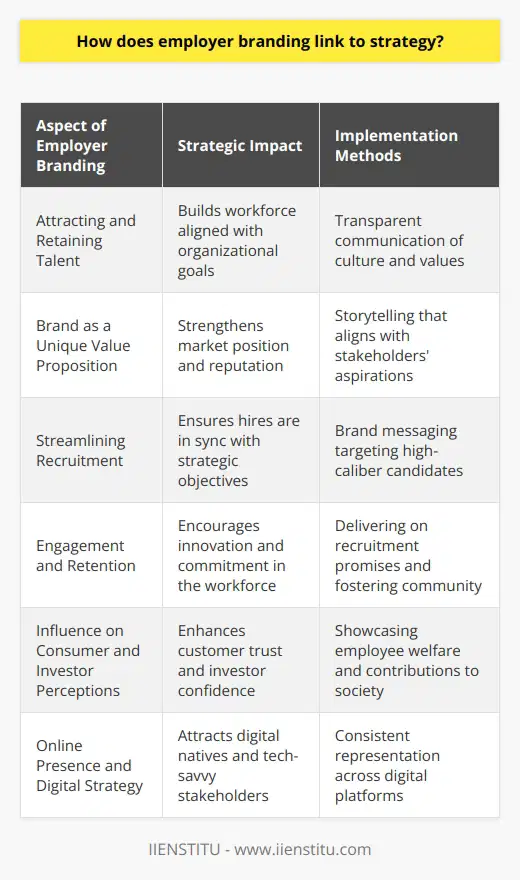
What is the role of organizational culture in employer branding?
Organizational Culture and Employer Branding
The role of organizational culture in employer branding is crucial, as it influences how prospective employees and stakeholders perceive an organization. Employer branding refers to the image and reputation of a company as an employer; it highlights the unique characteristics and values that make it an attractive location for potential employees. Organizational culture, on the other hand, refers to the shared values, beliefs, and practices that drive an organization's decision-making and behavior.
Impact on Employee Attraction and Retention
A strong organizational culture helps to shape a company's employer brand, which is essential for attracting and retaining top talent. A positive culture supports the attraction of highly skilled professionals who seek an environment that aligns with their personal values and fosters growth and development.
Positive Organizational Images
Organizational culture also shapes the public image of an organization, through consistent company values and behaviors that foster trust and credibility. A strong employer brand will be associated with a high-functioning organizational culture, which maintains a favorable reputation amongst external stakeholders, including customers, investors, and partners.
Establishing a Competitive Edge
In an increasingly competitive job market, companies must differentiate themselves as desirable employers. A well-defined organizational culture contributes to the development of an employer brand that sets a company apart from its competitors. This differentiation can provide the organization with a competitive edge in attracting and retaining the best talent.
In conclusion, organizational culture plays a vital role in shaping employer branding by influencing the perceived attractiveness of an organization among prospective employees and external stakeholders. A strong organizational culture fosters employee attraction, helps maintain a positive public image, and provides a competitive edge in the job market.
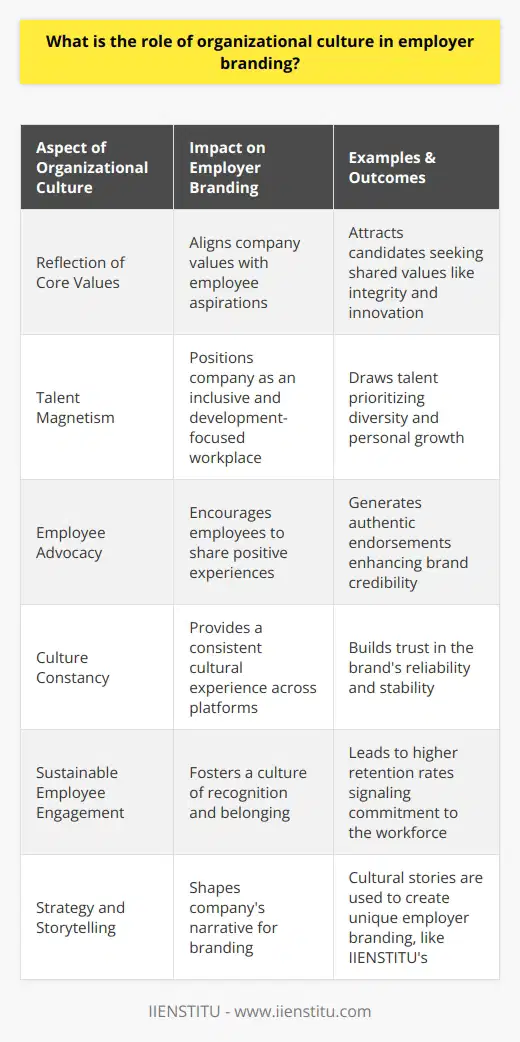
How can HR teams measure the effectiveness of their employer branding strategy?
Assessing Employer Branding Impact
The effectiveness of an employer branding strategy can be measured through the utilization of key performance indicators (KPIs) to evaluate its overall impact. HR teams can follow a systematic approach in order to obtain the desired results.
Attraction Rate
An important metric to consider is the attraction rate, which calculates the proportion of potential candidates who apply for a job after learning about the company's employer brand. A higher attraction rate reflects a more appealing employer brand, drawing the interest of the desired talent pool.
Quality of Applicants
To measure the success of an employer branding strategy further, HR teams should assess the quality of applicants achieved through the campaign. Evaluating the number of candidates meeting the job requirements and the proportion of the chosen applicants will provide valuable insights into the effectiveness of the employer brand.
Employee Engagement
Another vital metric to analyze is employee engagement. Engaged employees exhibit loyalty and satisfaction, becoming valuable ambassadors for the company. Employee engagement surveys can help gauge the extent to which employees identify with the employer brand, allowing HR teams to identify areas for improvement or reinforce strengths.
Retention Rate
In addition to attracting top talent, a successful employer branding strategy should aid in retaining valuable employees. Examining the retention rate within the organization will indicate the level of employee satisfaction with the company, thereby demonstrating the effectiveness of the employer brand in fostering a desirable work environment.
Time to Fill Positions
Lastly, the time taken to fill vacant positions can also serve as an indicator of the employer brand's effectiveness. A shorter duration implies that the company has been successful in generating interest and attracting the suitable candidates, whereas a lengthy time to fill suggests potential inefficiencies in the branding strategy that warrant further investigation.
In conclusion, HR teams can assess the effectiveness of their employer branding strategy by analyzing key performance indicators such as attraction rate, quality of applicants, employee engagement, retention rate, and time to fill positions. These metrics provide a comprehensive understanding of the employer brand's impact on both potential and existing employees, allowing necessary adjustments to refine the strategy and ensure overall success.
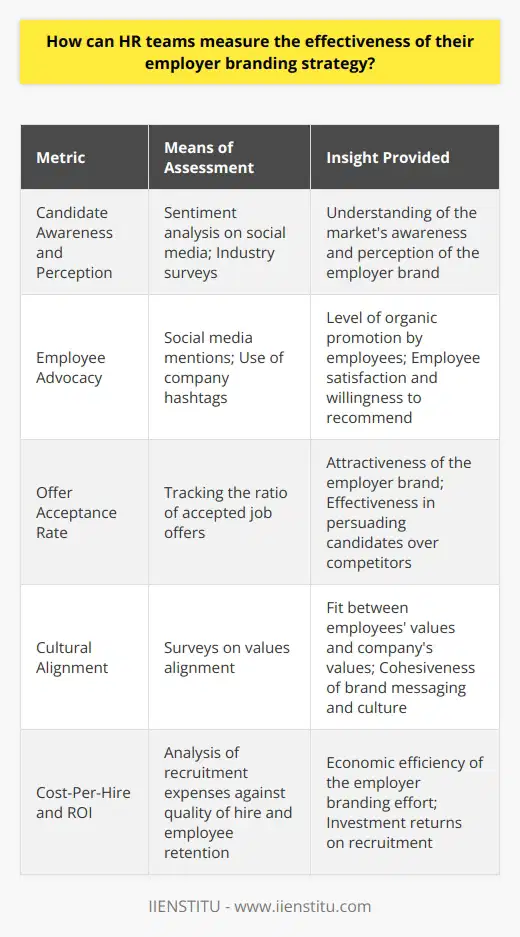
What are some common challenges faced by organizations in developing a strong employer brand?
Challenges in Developing a Strong Employer Brand
Identifying Key Values
Organizations face the challenge of identifying their core values and conveying them effectively. A strong employer brand requires clear messages that reflect a company's culture and work environment. Organizations must ensure that the identified values are authentic and resonate with their target audience, the potential employees.
Effective Internal and External Communication
Another challenge is the need for effective internal and external communication strategies. Internally, organizations must engage their employees to understand their perceptions and experiences. This helps in developing a more authentic employer brand. Externally, organizations have to select the right communication channels to reach their target audience and showcase their employer brand.
Maintaining Consistency
Consistency in communication and experience is crucial for building a strong employer brand. Organizations should ensure that the messages they convey align with the experiences employees have within the company. Inconsistencies between the employer brand and employee experience can harm an organization's reputation and deter potential talent.
Attracting and Retaining Talent
A strong employer brand should attract and retain the right talent. However, organizations face difficulty in differentiating themselves from competitors, particularly in competitive job markets. Companies must identify unique selling points that appeal to their target audience and promote these effectively to stand out from the crowd.
Adapting to Changing Trends
The employer branding landscape is constantly evolving, requiring organizations to adapt their strategies accordingly. Changing workforce demographics, new communication channels, and emerging workforce priorities are some factors organizations need to consider. A strong employer brand must remain relevant and appealing to the target audience, requiring continuous monitoring and updating.
Evaluating Employer Brand Success
Finally, measuring the success of an employer brand is another challenge organizations face. Traditional metrics such as employee turnover and time to hire are useful but may not provide a comprehensive understanding of the employer brand's performance. Organizations should consider alternative metrics, such as employee engagement, brand perception, and various recruitment outcomes, to evaluate the effectiveness of their employer brand accurately.
